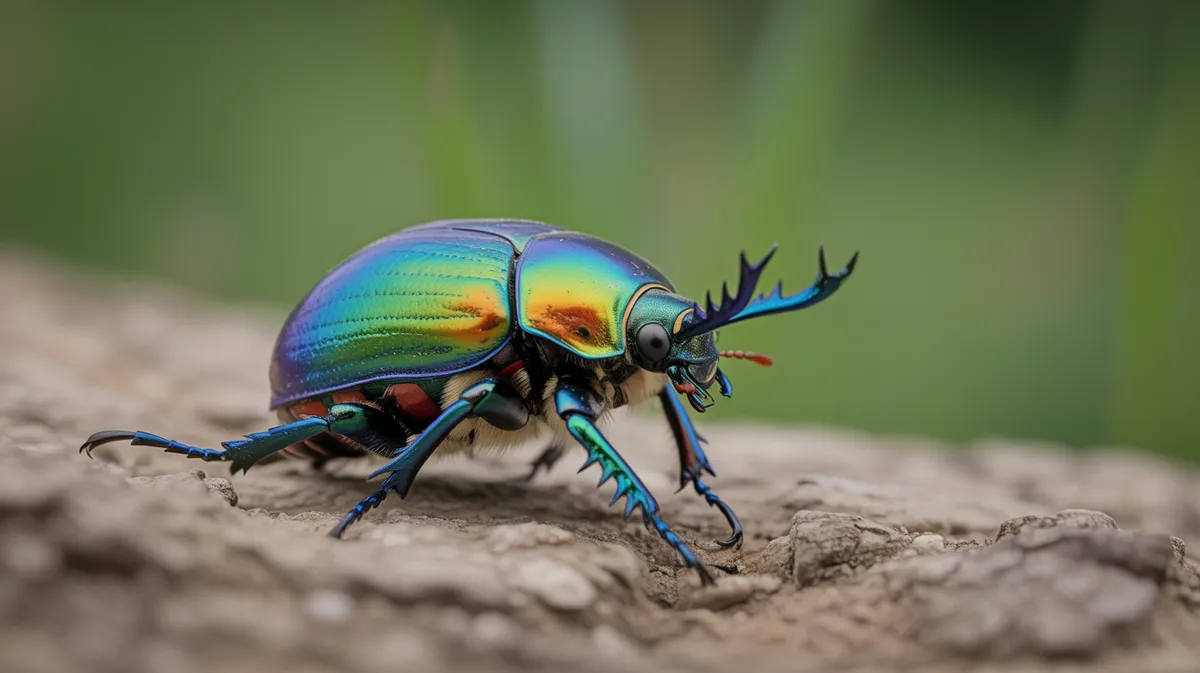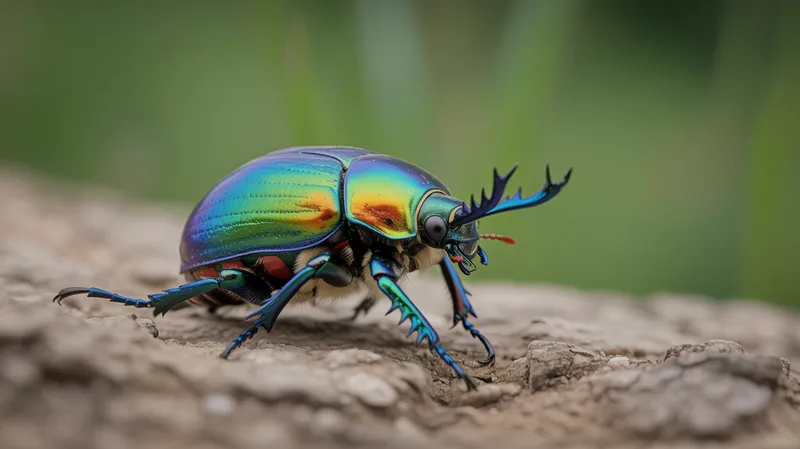
Rainbow scarab beetle
Phanaeus vindex

Meet the Rainbow scarab beetle
The Rainbow scarab beetle is a brilliantly colored dung beetle native to North America, known for its metallic green, gold, and copper hues. This beetle plays a vital ecological role by burying and consuming animal dung, which helps recycle nutrients into the soil. Males possess a prominent horn on their heads, which they use to compete for mates and territory. These beetles are most active during warm months and are commonly found in areas with abundant mammalian wildlife.
Classification
Invertebrate
Habitat
Grasslands and open woodlands
Diet
Detritivore
Lifespan
6 months to 1 year
Conservation
Least Concern
Weight
0.2 to 0.4 grams
📖Fascinating Facts
Brilliant Colors
The Rainbow scarab beetle’s exoskeleton displays dazzling iridescent greens, blues, and golds, making it one of the most colorful beetles in North America.
Dung Recycler
This beetle specializes in burying and feeding on animal dung, which helps fertilize soils and control parasites.
Horned Males
Male rainbow scarab beetles sport a large, curved horn on their heads used in fights with other males over mates.
📋Detailed Description
The Rainbow scarab beetle (Phanaeus vindex) is a medium-sized dung beetle, typically measuring 13–22 mm in length, with a robust, convex body and striking metallic coloration that ranges from iridescent green to gold and copper, sometimes with blue or violet highlights. The exoskeleton is smooth and highly reflective, aiding in camouflage among leaf litter and dung. Males are distinguished by a prominent, forward-curving horn on the head, which is used in combat with rival males, while females lack this horn but have a broader pronotum. The legs are strong and equipped with spines adapted for digging and manipulating dung. The antennae are clubbed and highly sensitive, allowing the beetle to detect dung from considerable distances. Phanaeus vindex is primarily crepuscular, being most active during dawn and dusk, and exhibits solitary or loosely aggregative behavior around dung resources. Its ecological role as a dung recycler is critical for nutrient cycling, soil aeration, and the suppression of parasites and pests in grassland ecosystems. The species is sexually dimorphic, with males and females differing not only in horn morphology but also in subtle coloration and body proportions. The life cycle includes egg, larval, pupal, and adult stages, with larvae developing underground in brood chambers provisioned with dung. Adults are capable of flight and can disperse over several kilometers in search of suitable dung sources.
💡 Did you know?
Despite their small size, a single pair of rainbow scarab beetles can bury more than their own body weight in dung in just a few hours.
🔬Research & Sources
🎭Behavior & Social Structure
Rainbow scarab beetles exhibit resource-based territoriality, with males competing for fresh dung pats using their horns in ritualized combat. Once a suitable dung source is located, a pair (male and female) will cooperate to excavate tunnels beneath the pat, where they form brood chambers. Both sexes participate in rolling, burying, and shaping dung into brood balls, which serve as both food and a developmental substrate for their larvae. Adults feed primarily on the liquid components of dung, using their mouthparts to filter nutrients. Activity peaks during warm, humid conditions, and beetles are rarely seen during cold or dry periods. They are generally solitary except during breeding or when multiple individuals converge on a large dung source. Flight is rapid and direct, and beetles are capable of orienting themselves using polarized light and possibly geomagnetic cues. They are also known to exhibit cleaning behavior, grooming their antennae and legs after handling dung.
👶Reproduction & Life Cycle
Breeding occurs primarily from late spring through early autumn, with peak activity in May to August. Males use their horns to compete for access to females and high-quality dung sites. After mating, the pair collaborates to excavate a tunnel beneath a dung pat, where the female shapes portions of dung into brood balls. She lays a single egg in each brood ball, which is then sealed in an individual chamber. The female may guard the brood chamber for a short period, but there is no extended parental care after egg-laying. The eggs hatch within 1–2 weeks, and the larvae feed exclusively on the dung provided, undergoing three instars over a period of 1–2 months. Pupation occurs within the brood chamber, and new adults emerge after 2–3 weeks, with the entire life cycle typically completed within 2–4 months depending on environmental conditions. Multiple generations may occur per year in warmer regions.
🛡️Adaptations & Survival
Phanaeus vindex exhibits several key adaptations for its dung-feeding lifestyle. The robust, spined forelegs are specialized for digging and manipulating soil and dung. The metallic, iridescent exoskeleton may provide camouflage among reflective surfaces and deter predators through aposematic signaling. The male's horn is an evolutionary adaptation for intraspecific competition, allowing males to physically displace rivals from dung resources. The highly sensitive, lamellate antennae are adapted for detecting volatile organic compounds emitted by dung, enabling efficient resource location. Behavioral adaptations include cooperative brood care and the construction of subterranean brood chambers, which protect developing larvae from desiccation, predation, and parasitism. The species' ability to fly long distances increases its chances of locating ephemeral dung resources and enhances gene flow between populations.
📚Research Sources
🎨Cultural Significance
Dung beetles, including Phanaeus vindex, have long been symbols of renewal, fertility, and transformation in various cultures, though this particular species is not as prominent in mythology as the scarabs of ancient Egypt. In North America, dung beetles are increasingly recognized for their ecological services, particularly in sustainable agriculture, where they contribute to pasture health and parasite control. They are sometimes featured in educational programs and natural history exhibits to illustrate the importance of decomposers in ecosystems. There are no known traditional medicinal or utilitarian uses specific to this species.
🔬Recent Research & Discoveries
Recent research has focused on the ecological impacts of dung beetles like Phanaeus vindex on nutrient cycling, soil structure, and the suppression of livestock parasites. Studies have shown that their activity can significantly reduce greenhouse gas emissions from dung pats and enhance soil fertility. Ongoing research is examining the effects of veterinary pharmaceuticals on dung beetle populations and the potential for using dung beetles as bioindicators of ecosystem health. Genetic studies are also underway to clarify phylogenetic relationships within the Phanaeini tribe and to assess population connectivity across fragmented landscapes. Behavioral experiments have explored horn size variation and its relationship to reproductive success, as well as the sensory mechanisms used in dung detection.
🎥Wildlife Videos

Meet a Beautiful Beetle That Loves to Eat Poop | National Geographic
Watch an entomologist search beneath piles of bison poop for rainbow scarabs, a beautiful dung beetle native to North America.
National Geographic

Rainbow Scarab Beetles Digging and Burying Dung
Where does all that doggy-doo in your yard go? (Well, maybe not ALL of it, unfortunately there's always *some* left to clean up!)
Michael Hogue

Are dung beetles important?
Have you ever seen a beetle rolling a ball of dung? Dung beetles are a fascinating group of animals and they are more important ...
Eco Sapien

The colorful world of insects
Marion Sloane

Little Bear Scarab Beetle
Little Bear Scarab Beetle Hi I'm Mr. Lucky and Welcome to my Channel B Love Nature. Please you guys follow with me to watches ...
B Love Nature

"Scarabaeidae: Nature's Ecological Engineers"
Scarabaeidae is a diverse and scientifically significant family of beetles commonly known as scarab beetles or simply scarabs.
mohamed moumaris
🌍Habitat Information
The Rainbow scarab beetle typically inhabits Grasslands and open woodlands environments. Rainbow scarab beetles have adapted to their environments with specialized features and behaviors.
Primary Habitat:
Grasslands and open woodlands
More detailed habitat information will be available soon.
🛡️Conservation Status
The Rainbow scarab beetle is currently classified as Least Concern. Conservation efforts are crucial for preserving this species for future generations.
Common Threats:
- 🏠Habitat loss and fragmentation
- 🌡️Climate change impacts
- 🎯Hunting and poaching
- 🏭Human-wildlife conflict
⚠️Threats & Conservation Challenges
Currently classified as Least Concern, Phanaeus vindex faces relatively few direct threats, but local populations may be impacted by habitat loss due to agricultural expansion, urbanization, and the reduction of large mammal populations (their primary dung source). The use of veterinary pharmaceuticals, particularly ivermectin, in livestock can render dung toxic to beetle larvae, leading to localized declines. Pesticide use and soil compaction from heavy machinery also pose risks to their subterranean brood chambers. Climate change may alter the timing and availability of dung resources, potentially affecting reproductive success and population dynamics. Despite these challenges, the species remains widespread and locally abundant across much of its range.
🔬Scientific Classification
Scientific Name
Phanaeus vindex
Classification Hierarchy
🔍 About Taxonomic Classification
Taxonomic classification is a hierarchical system used by scientists to classify and organize living organisms based on shared characteristics and evolutionary relationships.
The system moves from broad categories (Kingdom) to increasingly specific ones, with each animal's scientific name typically consisting of its Genus and species.
📝Community Notes
Share your observations and insights about the Rainbow scarab beetle with our community of wildlife enthusiasts.
Join Our Community
Sign in to share your observations and connect with fellow wildlife enthusiasts.
Sign In to ContributeNo community notes yet
Be the first to share your observations about the Rainbow scarab beetle!
Explore Rainbow scarab beetle
Select a tab above to learn more about this amazing animal.
📸Photo Gallery
No photos available for this animal yet.
🌟Discover More Wildlife
Continue your journey of discovery with more fascinating animals from our database
